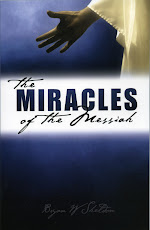The death of Christ provided both blood and water, as John witnessed, “But one of the soldiers with a spear pierced his side, and forthwith came there out blood and water” (John 19:34). John, emphasised the miracle of this divine provision with a threefold affirmation
(i) “And he who has seen has testified, and
(ii) “his testimony is true; and
(iii) “he knows that he is telling the truth, so that you may believe”. (John 19:35)
Blood and water are the two cleansing agents under the Mosaic dispensation. The Tabernacle and the Temple, the two centres where the principle of substitution was a daily occurrence, both had two pieces of furniture outside the Holy Place. A laver containing water for cleansing, and an altar which incorporated the shedding of blood, the primary cleansing agent. During the Temple period, the lambs brought for sacrifice were first washed in water, in the Pool of Israel, and then their blood was shed.
Again, the Law required the leper to be purified by the use of blood and water before he could be pronounced ritually ‘clean’. He would bath in water, and sacrifices would be made, the blood of which would be applied to his right ear, his right thumb and his right big toe.
Moses ratified the first covenant with blood and water. “For when Moses had spoken every precept to all the people according to the law, he took the blood of calves and of goats, with water … and sprinkled both the book, and all the people.” (Heb.9:19)
The second covenant was similarly ratified. At His last meal, the celebration of the Passover, the Messiah took the third cup, the cup of blessing and gave it a new significance. He said, “This cup is the new testament in my blood, which is shed for you” (Luke 22:20). The cup that He drank that night was not only wine but mingled wine and water, symbolising the sacred fluids that would pour from His side at the time of His execution.
While both blood and water are cleansing agents, those major passages that deal with the subject clearly indicate that blood is the primary cleansing agent. The passage that states that the first covenant was ratified by the use of blood and water continues, “This is the blood of the covenant which God has commanded you. Then likewise he sprinkled with blood both the tabernacle and all the vessels of the ministry. And according to the law almost all things are purified with blood, and without shedding of blood there is no remission.” (Heb.9:20-22) Jesus, while declaring the cup of mingled wine and water to be the symbol of His sacrifice, identifies the cup as “the new covenant in My blood”. When Moses took the water of the Nile and poured it out, it became blood on the ground. Blood is clearly the cleansing agent incorporated in a substitutionary sacrifice. John wrote, “the blood of Jesus Christ His Son cleanses us from all sin.” (1 John 1:7) It is most clearly stated in the songs of Revelation. “To Him who loved us and washed us from our sins in His own blood, and has made us kings and priests to His God and Father, to Him be glory and dominion forever and ever. Amen.” (Rev.1:5,6) An elder described the martyrs of the tribulation. “These are the ones who come out of the great tribulation, and washed their robes and made them white in the blood of the Lamb.” (Rev.7:14)
The propitiatory nature of His sacrifice is appropriated, “through faith in his blood” (Rom.3:25 (KJV)). Individuals are “justified by His blood” (Rom.5:9). Paul wrote, “We have redemption through His blood” (Eph.1.7; Col.1.14; 1 Pet.1.19; Rev.5.9), and “have been brought near by the blood of Christ” (Eph.2:13). Reconciliation and peace come through “the blood of His cross” (Col.1:20). It is the blood of Christ that purges the conscience. It is the blood of Christ that gives access to God. Sanctification comes through the blood of Christ.
While seemingly subordinate as a cleansing agent, water is not totally overlooked by the New Testament writers. John recorded the symbolic action of the Messiah in the upper room when Jesus washed the feet of the disciples. The mysterious word of explanation related to a secondary cleansing. Simon had protested and refused the foot washing, to which Jesus reacted, “If I do not wash you, you have no part with Me.” (John 13:8)Simon, missing the point asks for an additional cleansing. Jesus answered, “He who is bathed needs only to wash his feet, but is completely clean; and you are clean, but not all of you. For He knew who would betray Him; therefore He said, You are not all clean.” (John 13.:10,11) Clearly, the washing with water was symbolic and was perhaps connected with the requirement that priests in the Temple were not allowed to participate in sacrificial duties unless their feet were washed.
The figurative cleansing nature of water is emphasised by the rite of baptism. Ananias instructed Paul, “Arise and be baptized, and wash away your sins, calling on the name of the Lord.” (Acts 22:16) Paul referred to the symbolic washing with water in Ephesians, “Husbands, love your wives, just as Christ also loved the church and gave Himself for her, that He might sanctify and cleanse her with the washing of water by the word, that He might present her to Himself a glorious church, not having spot or wrinkle or any such thing, but that she should be holy and without blemish.” (Eph.5:25-27) The writer to the Hebrews does not overlook it. “Let us draw near with a true heart in full assurance of faith, having our hearts sprinkled from an evil conscience and our bodies washed with pure water.” (Heb.10:22)
Next Time - The Burial of the Messiah






No comments:
Post a Comment